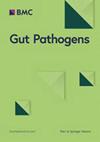2019-2022年COVID-19大流行期间肯尼亚沿海地区儿科住院病人常见肠道病毒阳性率的时间变化
IF 4.3
3区 医学
Q1 GASTROENTEROLOGY & HEPATOLOGY
引用次数: 0
摘要
在 2019 年冠状病毒病(COVID-19)大流行初期,为遏制严重急性呼吸系统综合征冠状病毒 2(SARS-CoV-2)的传播而实施的非药物干预措施(NPIs)极大地干扰了其他呼吸道病毒的活动。然而,来自中低收入国家(LMICs)的数据有限,无法确定这些非传染性疾病是否也影响了常见肠道病毒的传播。在此,我们调查了 COVID-19 大流行期间,在肯尼亚沿海地区一家转诊医院住院的腹泻患儿中,五种肠道病毒阳性率的变化情况。在2019年1月至2022年12月期间,基利菲县医院共采集了870份13岁以下儿童的粪便样本,并使用实时反转录聚合酶链反应对这些样本进行了轮状病毒A组(RVA)、诺如病毒基因II组(GII)、星状病毒、沙波病毒和腺病毒F40/41型的筛查。使用卡方检验统计量比较了四年中的阳性比例。在 282 个病例(32.4%)中检测到五种病毒中的一种或多种。从 2019 年(12.1%,95% 置信区间(CI)8.7-16.2%)到 2020 年(1.7%,95% 置信区间(CI)0.2-6.0%;P <0.001),RVA 阳性率有所下降。然而,在 2022 年,RVA 阳性率反弹至 23.5%(95% CI 18.2%-29.4%)。诺如病毒 GII 的阳性率在四年中有所波动,2020 年的阳性率最高(16.2%;95% C.I,10.0-24.1%)。2020年和2021年未发现天体病毒病例,但2022年的阳性率与2019年相似(3.1% (95% CI 1.5%-5.7%) vs. 3.3% (95% CI 1.4-6.5%))。与 2019 年(3.2%)、2020 年(6.8%)和 2022 年(2.1%)相比,2021 年(9.0%)的病死率更高(P < 0.001)。我们的研究发现,2020 年,肯尼亚基利菲常见肠道病毒(尤其是 RVA 和星状病毒)的传播可能因 COVID-19 NPIs 而中断。2020 年后,当地的肠道病毒传播模式似乎恢复到流行前的水平,这与大部分 COVID-19 非感染性政府禁令的取消相吻合。本文章由计算机程序翻译,如有差异,请以英文原文为准。
Temporal changes in the positivity rate of common enteric viruses among paediatric admissions in coastal Kenya, during the COVID-19 pandemic, 2019–2022
The non-pharmaceutical interventions (NPIs) implemented to curb the spread of severe acute respiratory syndrome coronavirus 2 (SARS-CoV-2) early in the coronavirus disease 2019 (COVID-19) pandemic, substantially disrupted the activity of other respiratory viruses. However, there is limited data from low-and-middle income countries (LMICs) to determine whether these NPIs also impacted the transmission of common enteric viruses. Here, we investigated the changes in the positivity rate of five enteric viruses among hospitalised children who presented with diarrhoea to a referral hospital in coastal Kenya, during COVID-19 pandemic period. A total of 870 stool samples from children under 13 years of age admitted to Kilifi County Hospital between January 2019, and December 2022 were screened for rotavirus group A (RVA), norovirus genogroup II (GII), astrovirus, sapovirus, and adenovirus type F40/41 using real-time reverse-transcription polymerase chain reaction. The proportions positive across the four years were compared using the chi-squared test statistic. One or more of the five virus targets were detected in 282 (32.4%) cases. A reduction in the positivity rate of RVA cases was observed from 2019 (12.1%, 95% confidence interval (CI) 8.7–16.2%) to 2020 (1.7%, 95% CI 0.2–6.0%; p < 0.001). However, in the 2022, RVA positivity rate rebounded to 23.5% (95% CI 18.2%–29.4%). For norovirus GII, the positivity rate fluctuated over the four years with its highest positivity rate observed in 2020 (16.2%; 95% C.I, 10.0–24.1%). No astrovirus cases were detected in 2020 and 2021, but the positivity rate in 2022 was similar to that in 2019 (3.1% (95% CI 1.5%–5.7%) vs. 3.3% (95% CI 1.4–6.5%)). A higher case fatality rate was observed in 2021 (9.0%) compared to the 2019 (3.2%), 2020 (6.8%) and 2022 (2.1%) (p < 0.001). Our study finds that in 2020 the transmission of common enteric viruses, especially RVA and astrovirus, in Kilifi Kenya may have been disrupted due to the COVID-19 NPIs. After 2020, local enteric virus transmission patterns appeared to return to pre-pandemic levels coinciding with the removal of most of the government COVID-19 NPIs.
求助全文
通过发布文献求助,成功后即可免费获取论文全文。
去求助
来源期刊

Gut Pathogens
GASTROENTEROLOGY & HEPATOLOGY-MICROBIOLOGY
CiteScore
7.70
自引率
2.40%
发文量
43
期刊介绍:
Gut Pathogens is a fast publishing, inclusive and prominent international journal which recognizes the need for a publishing platform uniquely tailored to reflect the full breadth of research in the biology and medicine of pathogens, commensals and functional microbiota of the gut. The journal publishes basic, clinical and cutting-edge research on all aspects of the above mentioned organisms including probiotic bacteria and yeasts and their products. The scope also covers the related ecology, molecular genetics, physiology and epidemiology of these microbes. The journal actively invites timely reports on the novel aspects of genomics, metagenomics, microbiota profiling and systems biology.
Gut Pathogens will also consider, at the discretion of the editors, descriptive studies identifying a new genome sequence of a gut microbe or a series of related microbes (such as those obtained from new hosts, niches, settings, outbreaks and epidemics) and those obtained from single or multiple hosts at one or different time points (chronological evolution).
 求助内容:
求助内容: 应助结果提醒方式:
应助结果提醒方式:


